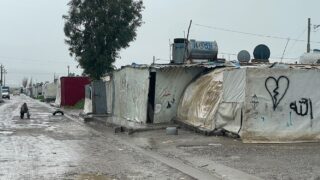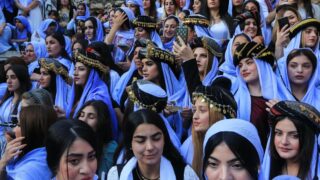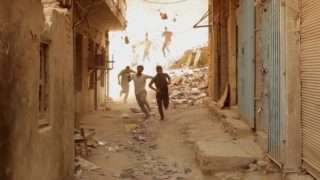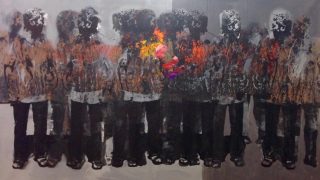Donald Rumsfeld and Paul Bremer told Americans that the Iraq they had invaded was a country divided by sects, religious and ethnic: Shi’ite and Sunni, Arab and Kurd. But as Harith Hassan points out in this striking essay from Al Safir Al Arabi, the Sunnis of Iraq in 2003 did not think of themselves as belonging to a sect at all. The decade long post-invasion struggle has been in large part an extraordinarily violent process of redefining the country’s Sunni Arabs as a distinctive sect, rather than the country’s norm, its dominant elite.
It is a commonplace to note that throughout its modern history, up until the American invasion of 2003, Iraq was ruled by Sunni Arab elites. The Sunnis who governed the country after 1921 constructed an Iraqi nationalist narrative to disguise their own lack of legitimacy as sole rulers of an extremely diverse and fragmented society.
But over the years, the ability to camouflage that Sunni domination began to erode, due to changes in the formation of these hegemonic elites, and in particular to the disappearance of the type of liberal “Iraqism” represented by such public figures as [architect and writer]Kamil Chadirji, [newspaper publisher]Hussein Jamil, and others like them who had sought to create a model for Iraqi nationalism that was less authoritarian and more open.
Over the years, the Sunni elite became more militarized and more secretive, leaving it increasingly vulnerable to the tribal and regional alliances which began forming in the years of Ahmed Hassan al-Bakr [president from 1968-79]and Saddam Hussein [1979-2003].
This return to loyalties based on kinship and traditional tribal affiliation finished off what was left of the project of Iraqi political modernity. It even killed off the secular, ideological dimension of the ruling Baath party itself, as the formerly nationalist party was transformed in the 1980s into nothing more than a security apparatus utterly compliant to the will of Saddam Hussein.
Other intellectual and social institutions which might have lessened the influence of exclusionary tribalism also crumbled under the successive blows of militarization, extreme repression and the dictates of Saddam Hussein’s cult of personality.
As a result, those Iraqis who were marginalized and resentful found shelter in alternative loyalties, returning to pre-state territories now that the state had become nothing more than a regime.
So it was that political Shi’ism began presenting itself as the alternative to rule by the “Sunni minority.” This narrative rationalized the switch in roles when Shi’ites took over following the 2003 invasion: it was past time for the “majority to govern.”
It was with this kind of simplistic logic, this superficial account of majority and minority, that Iraq’s Sunnis were informed that they were a “sect” and that their “Sunni Iraqi sect” must now accept a smaller portion of power commensurate with their sect’s size in the country: they were now a “minority.”
Unlike the Shi’ite sect, or the nation of the Kurds, the Sunnis of Iraq had not yet been transformed into a sect. A sect after all is not merely a classification imposed from above: it is a social body with its own institutions, its own social bases, and its own narratives.
The Shi’ite sect’s regeneration in Iraq came partly as a reaction to the sense of exclusion on the part of the country’s Shi’ites, who were first marginalized by the forced secularization of their religious institutions and then bathed in the brutal violence of the Saddam Hussein regime against them. But Shi’ite religious institutions in Iraq survived, and maintained their social legitimacy; for that reason they have been able to continue to shepherd members of the sect, and offer them a moral compass to follow.
Sunnis on the other hand never needed to develop the institutional apparatuses of a “sect,” in the sense of a social body with the material and intellectual resources to ensure its own continued existence. They had control of the state itself and that was more than enough. Their sect was the state itself, since the networks of religious solidarity and cooperation they needed were built into the very structure of the state.
The state’s official ‘Arabism’ became their default identity ,the more so among the rural elites, whose embrace of Arabism was of a more tribal type. Hence most Sunnis had little sense of following a ‘Sunni’ doctrine or belonging to a ‘Sunni’ sect.
But when the regime/state collapsed with the invasion, the Sunnis suddenly found themselves battered by an enormous identity crisis: they were told that they were ‘Sunnis’ but the word actually held little meaning for them.
Meanwhile, the Shi’ite hawza [religious school]and religious authorities of the city of Najaf was able to fill the void that suddenly appeared when the state vanished. In spite of the internal competition and strife that did erupt among the country’s Shi’ites at this point, these institutions were able to compel a kind of regularity on the overall collective behavior of the Shi’ites.
This was illustrated well during the 2004 showdown between US occupation chief Paul Bremer and Ali al-Sistani over the drafting of the constitution. The Shi’ite Marja’ displayed his power by calling massive demonstrations to demand that the constitution be written by Iraqis, and that early elections be held, and Bremer finally backed down.
In “Sunniland” meanwhile, events were not following a similar path.
The Sunnis had immediately split into numerous groups. There were those who insisted on rejecting the rise of sectarianism, continuing to mouth the traditional slogans of Iraqi nationalism or political ‘Arabism.’ There were others who adopted Islamist positions, many of who went on to wage jihad against the Americans. Others returned to the bosom of the tribe, and still others who began to identify with internationalist Salafi [Sunni fundamentalist] and extremist sectarian perspectives.
All of these groups fought to impose their own alternative identities on the rest. And this was not merely a struggle between Sunnis; it involved the others as well. The other Iraqi sects, obsessed with the abuses that had been heaped upon them in earlier years, insisted on the construction of a ‘New Iraq’ based upon the emotions those injustices had imprinted upon them, and they thereby lost the opportunity to contain Sunni restlessness or redirect it in new and meaningful ways.
Instead, they participated in the creation of the Sunnis’ own litany of abuses, opening wide the gates to the doctrine of Sunni vengeance incarnated in DAESH[ISIS].
So it was that DAESH appeared, not as what the majority of Sunnis actually wanted, but as a force that was prepared to fill in the vacuum of power and the void of meaning for Sunnis. And so it is that the challenge for today is not only confronting DAESH now, but considering how to conduct the post-DAESH era.
Hence the emergence of the idea of a ‘national guard,’ a kind of Sunni version of the Kurdish Peshmerga, a force that would be in harmony with its own local populations and capable of attaining internal legitimacy, and more importantly regaining the legitimacy that has been hijacked by DAESH.
But here we would face a new dilemma, one that directly contradicts the project of state-building. The presence of Sunni, Shi’ite and Kurdish armed forces in three distinct geographical areas would constitute a new step toward national fragmentation and would perhaps bring its own new challenges.
That is why there is now a competition to determine who would be at the head of such a force if it were to be created. The Shi’ites want to see it under the authority of the “Shi’ite Prime Minister,” while the Sunnis want to see such a force have local autonomy. With this autonomy, it would essentially be an armed wing of the country’s Sunnis, and would thereby give them more leverage during negotiations with their adversaries. Such negotiations have of course not even been possible so far since the collapse of Saddam-Iraq, given the instability of the Sunnis as a group.
So today we are at a new crossroads, or rather perhaps we are now confronting a fundamental question that could be ignored back when there were more than 180,000 American soldiers in the country: who if anyone has the ability to impose a new narrative on the political community that is Iraq, via [what German Sociologist Max Weber called]the “monopoly of legitimate violence ,” and who exactly will determine if it is legitimate?
The answer to this question will still depend on the outcome of the current fight against DAESH, and on how the void gets filled after this fight ends.
It seems that the general sentiment now that Nuri al-Maliki has departed, is for compromise; and much of the political elite now seems to have realized that there will be no way out without compromise. But a climate of suspicion remains in the air, and a tendency toward opportunism is evident on all sides, and everyone is trying to impose a new reality by establishing facts on the ground.
The Iraqi national army has to a large extent become synonymous with the Shi’ite militias who fight to protect the Shi’ite religious doctrines, while the Kurdish Peshmergas are focused on drawing expanded frontiers for their own ‘regional state’—the president of Kurdistan having declared that the frontiers drawn in the colonial era Sykes-Picot agreement were artificial, and that the new maps must be drawn with blood.
Meanwhile the Sunni partner is still absent; while DAESH is pulling it toward total war, the sect’s political class, which is located in Baghdad, as well as in Irbil and across the border in Amman-gives the impression of a class that is living in exile, making it difficult for other partners to take seriously.
In the end, we will probably have to wait to know if the events of today are still the continuation of the civil war that began in 2003, only now being resolved to the advantage of the victorious party, and via the redrawing of more stable boundaries between all the parties to that conflict. Or if these events are instead the beginning of a new social and political accord which will redefine Iraq on a new basis. Or if perhaps both interpretations are correct, and both civil war and new accord are happening at the same time.
Until we arrive at the end point, Iraq-like many countries in the region-will be a country experiencing a transition whose outcome is entirely up in the air. An authority that is capable of achieving the state-defining monopoly of violence, and of thereby constructing its own legitimacy-has yet to emerge.
And so the Iraqi people continue to inhabit a muddy ground between a state and a proto-state; they still have no answer for the question of how to manage their own coexistence, or how to simply put an end to that coexistence.
Translated by International Boulevard







